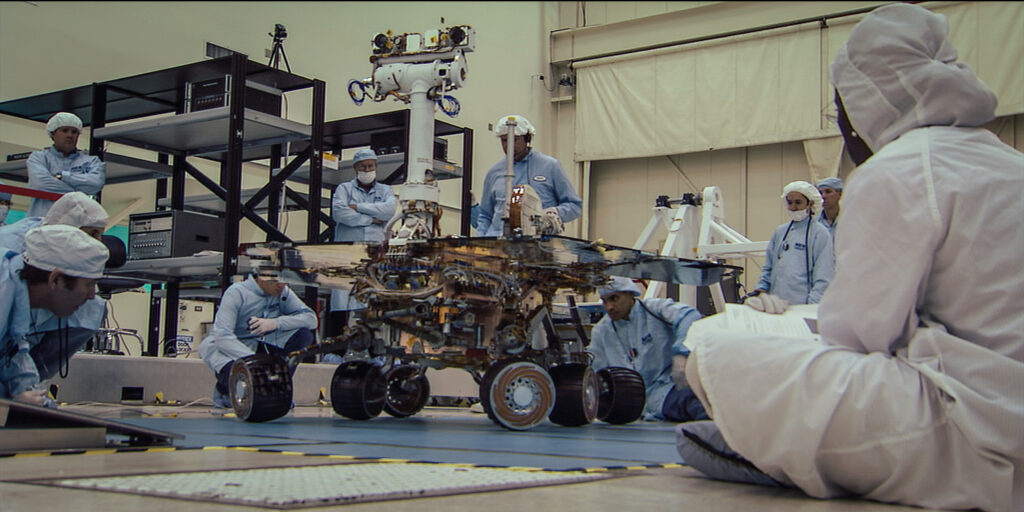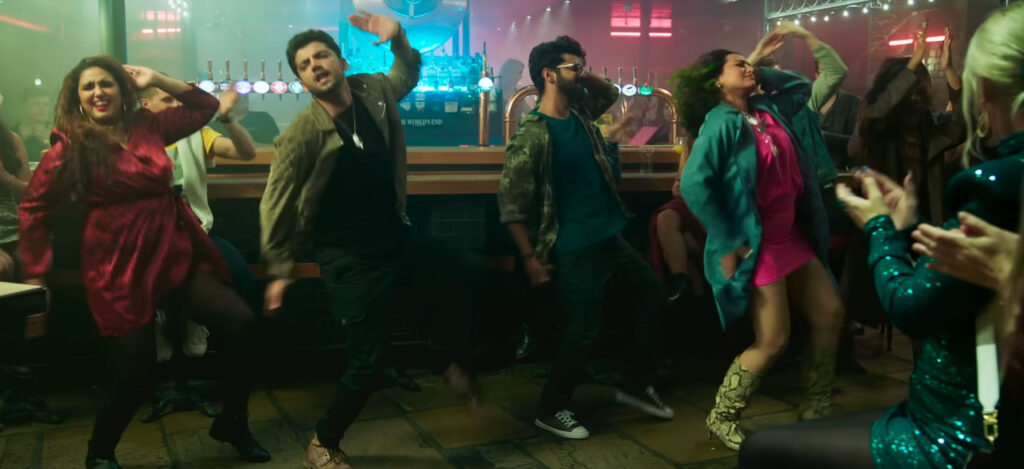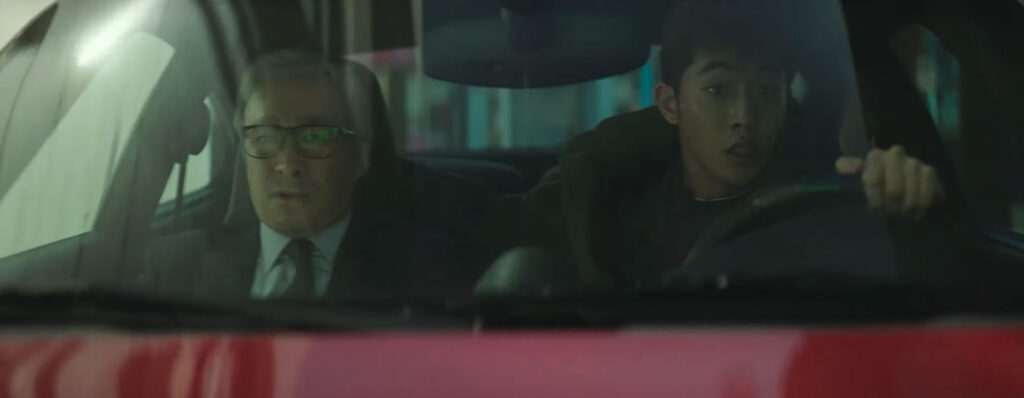November 13, 2022
by Carla Hay

Directed by Mathukutty Xavier
Hindi with subtitles
Culture Representation: Taking place in Dehradun, India, the dramatic film “Mili” features an all-Indian cast representing the working-class and middle-class.
Culture Clash: A few days before she is supposed to move to Canada for a nursing job, a 24-year-old woman, who has recently become estranged from her widower father, gets accidentally trapped in the freezer room of the fast-food restaurant where she works.
Culture Audience: “Mili” will appeal primarily to people interested in watching suspenseful survival thrillers with meaningful messages about love and trust.

“Mili” is a capable 2022 Hindi remake of the 2019 Malayalam film “Helen,” which are both dramas about a young woman who accidentally gets trapped in a restaurant’s freezer room. “Mili” takes its time to get to the suspenseful part of the movie, but it’s worth the wait. The acting performances are very good, while the movie’s editing and musical score skillfully increase the tension. “Mili” is the type of film where viewers will probably be able to predict how everything is going to end, but the movie has enough twists and turns to keep audiences on edge to see what will happen next.
Directed by Mathukutty Xavier and written by Ritesh Shah, “Mili” takes place in Dehradun, India, where 24-year-old Mili Naudiyal (played by Janhvi Kapoor) lives with her widower father Niranjan Naudiyal (played by Manoj Pahwa), who works as an insurance agent. (“Mili” was actually filmed in Dehradun and Mumbai.) Mili is an only child who is a graduate of nursing school. She works part-time as a cashier at a fast-food restaurant named Doon’s Kitchen (which is located inside a shopping mall), and she attends International English Language Testing System (IELTS) classes.
Mili is learning English because she wants move to Canada, where she plans to continue her nursing training and find a job as a nurse. In the beginning of the movie, Mili has already made up her mind to move to Canada, where nurses are paid a much higher salary than what Mili could earn as a nurse in India. Niranjan is not happy about Mili’s decision to move to another country so far away, but there’s nothing he can really do about it. Mili says if she stayed in India, she wouldn’t earn enough money to get herself out of her student loan debt in a reasonable period of time.
Mili’s mother died when Mili was a very young child, and her father has not remarried. And so, Mili has spent most of her life living in a household with just herself and her father. Mili and Niranjan have a very close and loving father/daughter relationship overall. The only things they disagree about are where Mili will live (her father wants her to live close to him in India) and Niranjan’s habit of smoking cigarettes. Mili sternly lectures him that he needs to quit smoking for his health, but Niranjan sometimes sneaks in some smoking when he thinks Mili won’t find out.
Mili has been keeping her own secret from Niranjan that will put their relationship to the test: Mili has been dating a guy who’s unemployed, has a history of violence, and is from a different caste. His name is Sameer Kumar (played by Sunny Kaushal), and he’s about 10 years older than Mili. Sameer and Mili met at a hospital where she worked when Sameer was admitted to the hospital for injuries he sustained during a fight. Mili hasn’t told her father about Sameer because she knows that her father wouldn’t approve of her dating Sameer.
Mili and Sameer’s relationship has been turbulent with arguments that don’t turn violent, but it’s implied that these arguments are emotionally hurtful enough that Mili is on the verge of breaking up with Sameer. In the beginning of the movie, Sameer begs Mili to forgive him for something that he did that happened before this story takes place. Mili refuses to forgive Sameer and doesn’t really want to talk to him.
Sameer shows signs of having a nasty temper when he happens to see Mili walking down a street, and he notices that a rickshaw driver (played by Lovekush Kundu) has whistled at Mili. An enraged Sameer lunges at the rickshaw driver and roughs him up after Mili has walked away. Sameer yells at the driver that the woman he was whistling at is Sameer’s girlfriend and that the driver is being disrespectful when he whistles at women in that way.
Sameer’s attack isn’t enough to severely injure the driver, but it’s enough to cause intimidation to the driver, who fearfully says that he’s sorry and backs away from Sameer. This assault will make viewers wonder how much of a loose cannon Sameer is and if he can be trusted. Mili and some other people throughout the movie have those same doubts. Is Sameer going to redeem himself?
Sameer is so desperate for Mili’s forgiveness that he shows up at Doon’s Kitchen while she’s working and demands to talk to her. Sameer won’t leave until she gives him a chance to show her how sorry he is for whatever caused the argument. Eventually, Mili relents and agrees to talk to Sameer, who knows that Mili is going to move to Canada in the near future. Sameer has some news of his own: He got a job in Delhi, and he will be moving there the following night.
It’s a shock to Mili, but she figures that Sameer’s relocation is for the best, since they were close to breaking up, and they were going to be living a long distance from each other anyway. Mili agrees to Sameer’s invitation to go on one last date with him before he leaves the next night to go to Delhi. After her work shift ends, Mili and Sameer go on his motorcycle to a local nightclub/bar, where they both drink some alcohol and stay out very late. Sameer drinks more alcohol than Mili does and probably shouldn’t be operating any vehicle when they both leave the bar. Sameer offers Mili a ride back to her home.
But trouble comes when Sameer and Mili are riding on the motorcycle and are stopped on the street by an aggressive police sub-inspector named Satish Rawat (played by Anurag Arora), who rudely asks them why they are out on the street so late at night. From the beginning, Satish’s attitude is that he wants to find a reason to detain or arrest Sameer and Mili. Satish begins to interrogate them, by asking their names, where they came from, and where they’re going.
Satish scolds Mili by telling her that he thinks she’s a “loose woman” who shouldn’t be on the back of a man’s motorcycle so late at night. As soon as Satish finds out that Mili and Sameer just left a nightclub/bar, he demands that Sameer take a breathalyzer test. Sameer fails the test, so he and Mili are quickly detained and taken to the police station where Satish works.
Mili feels humiliated and even more ashamed when her father has to come to the police station to pick her up. Mili won’t be facing any criminal charges, but Sameer will likely be charged with driving while intoxicated. When Niranjan arrives at the police station and finds out what happened, it’s how he also finds out that Mili has been dating Sameer. Before Mili and her father leave the police station, Satish lectures Niranjan and Mili for not doing a better background check on Sameer, who gets bailed out of jail later.
Naranjan is so angry at Mili that he stops talking to her. Mili begs for his forgiveness but he completely shuns her. Feeling hurt, rejected and isolated, Mili goes to work the next evening at Doon’s Kitchen, where she is working the last shift for the night. Her cranky boss Sudheer Malkoti (played by Vikram Kochhar), who is distracted by his marital problems, reprimanded her a few days earlier, when he blamed Mili and another employee for letting 10 boxes of food get destroyed by an undetected rat in the stock room.
After the restaurant is closed for the night, Mili clocks out and is about to leave the restaurant when two co-workers named Ladoo (played by Raghav Binani) and Vipul (played by Deepak Simwal) suddenly show up with some boxes of frozen food. Vipul and Ladoo ask her to help them, because Ladoo and Vipul forgot to put these boxes in the freezer earlier. Ladoo and Vipul don’t want Doon’s Kitchen manager Sudheer to know that they were late in delivering the boxes, so Ladoo and Vipul ask Mili to carry the boxes herself into the freezer room (which is in the back of the restaurant), and she reluctantly agrees.
Ladoo and Vipul then clock out and leave the restaurant, while Sudheer is in another part of the restaurant. When Sudheer goes into his office, he sees on his computer that all of the employees have clocked out for the day, so he thinks he’s alone in the restaurant. Unbeknownst to him, Mili is in the freezer room. She has left the freezer room door slightly open, but not wide enough for Sudheer to see her inside the room.
Sudheer sees the door is slightly open, looks annoyed that an employee left the door open, and shuts and locks the freezer room door behind him. He then locks up the restaurant, and he leaves to go home for the night. Mili is now trapped in the freezer room and is completely alone in the restaurant.
And unfortunately, Mili left her phone and her purse in another room outside the locked freezer. The freezer room does not have an emergency alarm or a way to be unlocked from the inside. Mili is also wearing a short-sleeved shirt. And the temperature will eventually drop to freezing temperatures that can cause hypothermia and eventually death if she doesn’t get out of the room in time.
Mili’s entrapment in the freezer room doesn’t happen until about 45 minutes into this 127-minute movie. For some viewers, that might be too long for the movie to become suspenseful. And some scenes in Mili’s backstory weren’t really important and could have been cut from the movie. However, it was necessary to show what Mili’s life was like before she went through this ordeal, in order to understand other things that happen in the desperate search to find her.
When Niranjan sees that Mili has not come home when she was expected, he immediately tries to find out what happened. Niranjan knows that Mili is a very responsible person who sticks to a routine. He knows something is very wrong about why Mili didn’t come home that night without contacting him and because she’s not replying to his phone messages.
Sameer was on a bus to Delhi that night, but just by coincidence, he changed his mind and got off the bus. When he finds out that Mili has gone missing, he helps in the search, but he falls under suspicion for her disappearance. Sameer is eventually asked why he didn’t go to Delhi that night, and he says it’s because he changed his mind about taking the job there.
Doon’s Kitchen manager Sudheer is questioned about Mili’s whereabouts, but he insists that Mili left the restaurant because he saw that she had clocked out for the night. It’s why the people looking for Mili think she might be somewhere else during this frantic search. Certan prejudices that people had before Mili disappeared end up complicating matters and actually make things worse by causing mistrust and miscommunication.
In addition to Niranjan and Sameer, other people who help in looking for Mili are her best friend Hasleen (played by Hasleen Kaur), who also works at Doon’s Kitchen; Niranjan’s friend/neighbor Mohan Chachu (played by Rajesh Jais); an unnamed shopping-mall security guard (played by Niranjan Asrani); police inspector Ravi Prasad (played by Sanjay Suri), who is Satish’s immediate supervisor; and police officer Mukesh Singh (played by Manohar Teli), who is as compassionate as his sub-inspector boss Satish is cold-hearted. Rather than helping the investigation, Satish hinders it in many ways because of his selfishness, incompetence and personal biases.
“Mili” (which is being advertised as “based on true events”) can get melodramatic at times, but the movie never strays too far from reality. Kapoor’s empathetic portrayal of Mili anchors the film in a convincing way that will make audiences completely root for Mili in her fight for survival. All of the other cast members give solid performances in their roles.
The movie’s musical score by Oscar-winning “Slumdog Millionaire” composer A.R. Rahman is a tremendous asset in immersing viewers of “Mili” into every emotion felt by the principal characters. Even with a somewhat slow start, “Mili” ends up delivering an overall entertaining thrill ride that will certainly make people think twice about walking into a freezer room without safety precautions.
Zee Studios released “Mili” in select U.S. cinemas and in India on November 4, 2022.


















